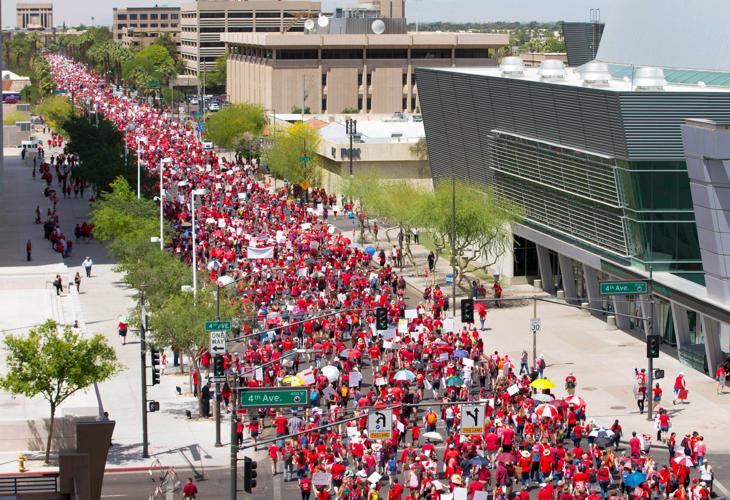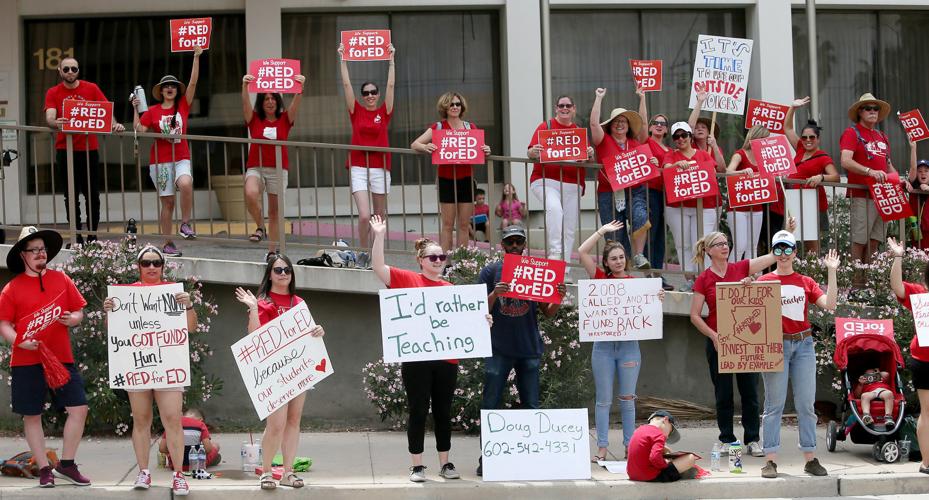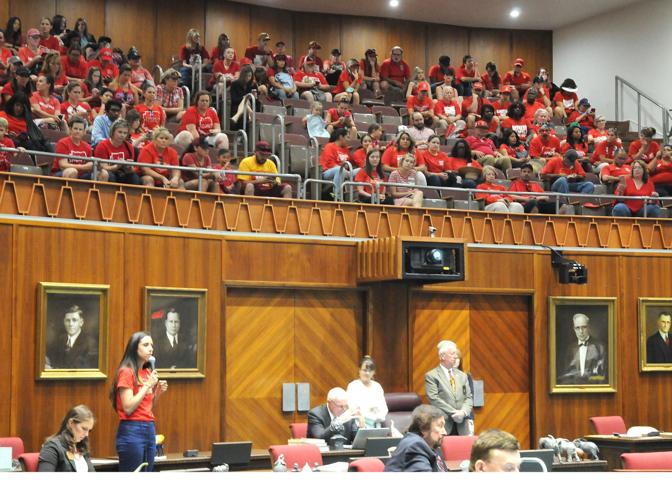Republican legislative leaders were closing in on a deal late Thursday to give Gov. Doug Ducey the pay hike he wants for teachers — but not the package being demanded by tens of thousands of educators who walked off the job.
The plan is to provide Ducey with the 19 percent increase for teacher pay — he says it’s 20 percent if you count the 1 percent salary hike already in this year’s paychecks — assuming that funding details can be worked out for other noneducational programs, like health care for the poor and aid to counties.
It also means that lawmakers will not demand that Ducey provide a dedicated revenue source for the more than $1 billion price tag for his entire education package.
But there is still no agreement on exactly how those dollars will be divided up.
Sen. John Kavanagh, R-Fountain Hills, said it isn’t a simple matter of saying that teachers will get a 20 percent pay raise by the 2020-2021 school year.
Kavanagh, who chairs the Senate Appropriations Committee, said the plan as crafted by Ducey is worded in a way that teachers — and only teachers — would get a 9 percent increase this coming school year, another 5 percent the year after that and 5 percent more the third year. But that, he said, means each new raise is compounded on the other, making the effective net pay increase actually more than 20 percent.
A potentially more troubling sticking point is whether schools will have to spend the $670 million for teacher salaries strictly on that.
“We want to be assured that the money is directed to pay increases,” Kavanagh said. But he said it’s not that simple.
He said some school districts, including in Scottsdale, already have raised teacher pay by 14 percent, putting off things like repairs. Kavanagh said there is some sentiment to allowing school boards to use the new “teacher pay” money to backfill those repair accounts.
One option, Kavanagh said, would be to give school boards more leeway — but only after a public vote, what he called “kind of a shaming.”
And then there’s the question of whether the dollars for teacher pay have to be divided up evenly. Kavanagh said some districts might want to use the lion’s share of their dollars to sharply bump up the salaries of new teachers.
While there may be enough GOP votes for the package, none of this is likely to satisfy members of the #RedForEd movement, who drew more than 50,000 supporters to a rally at the Capitol on the first day of the strike.
Showing solidarity with those at the Capitol were more than 1,000 educators and supporters who turned out for downtown Tucson’s #RedForEd rally, lining west Congress Street as horns of public support blared.
Joe Thomas, president of the Arizona Education Association, pointed out to supporters that the plan provides for a pay hike solely for classroom teachers. Left out are support staff like counselors, custodians, bus drivers and teaching aides.
“The governor thinks he’s going to buy enough of you off that you’ll shut up and go back to the classroom,” he said. And Thomas said nothing the governor is offering deals with other demands, like restoring the cuts that have been made in state funding to education that currently leaves per-student funding in Arizona below where it was a decade ago, even before inflation is taken into account.
The governor has countered that his plan also would restore $371 million in school district assistance during the next five years, money that was denied during the recession. Ducey said these dollars do not have a lot of strings, giving school officials sufficient latitude to provide raises for those who are not teachers.
What’s also missing, Thomas said, is a demand by educators to restore student funding to where it was a decade ago.
Wendy Gutierrez, a third-grade teacher at Elvira Elementary in the Sunnyside Unified School District, has 31 students in her classroom. The classroom set of crayons she receives at the beginning of the school year only contains 24 boxes. So she ends up buying more crayons for her students every year, along with more paper, glue, chairs and a host of other school supplies, which she estimates costs her $100 per month from her own pocket.
“I don’t feel my kids are left behind in any way, but that’s because I’m willing to do whatever it takes (to get them resources),” she said.
Twelve years ago, when Gutierrez first started teaching, she was earning $37,000. Today, her base salary is $38,000.
In that decade-plus, her school has eliminated its supply closet, pushing the cost onto teachers, and cut teachers aides from eight to four.
“It wasn’t great (a decade ago), but it was a lot better than it is now,” she said.
And then there’s the fact that Ducey says the cost of the package can be financed through economic growth, with no new taxes.
On that last point, the educators find themselves in agreement with Ducey’s predecessor.
“They need a permanent funding source moving forward,” said former Gov. Jan Brewer, calling the idea of financing the $1 billion package with future tax collections and cost savings “just pie in the sky.”
Lack of revenues aside, Brewer said Ducey stumbled in, rolling out a hastily crafted plan which actually has yet to be reduced to an actual written proposal. Instead, Ducey went from defending his original plan for a 1 percent pay hike on April 11 to unveiling and promoting this three-step 19 percent plan just two days later, all without actual legislation.
“They should have had a bill,” Brewer said. More to the point, she said, any proposal needs to be credible, something the governor and his aides can “explain to the public.”
While Republicans may be ready to vote for a plan, Sen. Steve Farley, D-Tucson, warned colleagues of a potentially unintended effect if lawmakers approve the additional dollars that the governor wants.
He pointed out that voters in 2016 approved Proposition 123. It will add $3.5 billion in aid to schools between now and 2025 after the Arizona Supreme Court ruled the state had not met its constitutional obligation to increase state aid annually to keep pace with inflation.
But that measure contains a poison pill of sorts: It put a provision in the Arizona Constitution to say that, beginning in 2024, lawmakers would no longer have to finance future inflation increases if K-12 funding exceeds 49 percent of the entire state budget.
Farley said an analysis of Ducey’s plan by legislative budget staffers show that by the 2020-2021 school year, aid to education will hit 48.6 percent. But he said the provision would be triggered if lawmakers approve future tax cuts that trim overall state spending.
The solution, said Farley, is an outside, dedicated revenue source to keep overall spending on state government high enough not to trigger the cut in education funding.
Senate President Steve Yarbrough dismissed that claim as “disingenuous.”
He said the state is bringing in more dollars. And Yarbrough pointed out that the governor on Wednesday signed legislation to increase the vehicle license fee, a move he said could free up more than $100 million for state needs.







